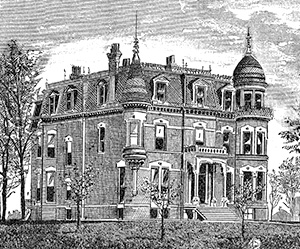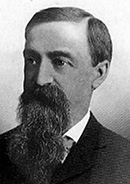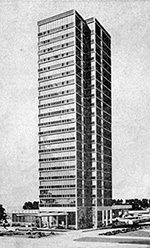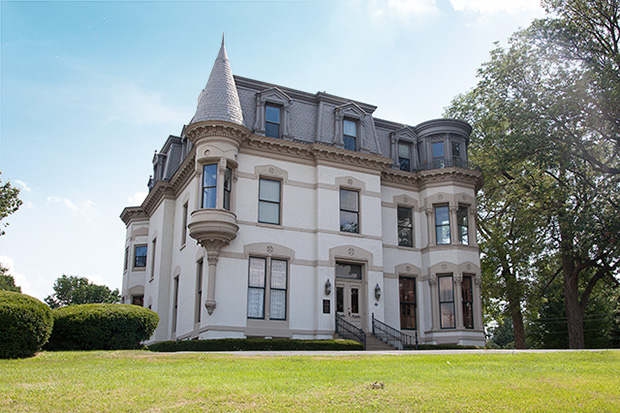
Converse Marketing has had three unique homes in its nearly 25 years in business — a 700-foot space in the basement of our founder's house, a 4,000-square-foot brownstone in downtown Peoria, and our current home: the 11,000-square-foot Second Empire-style residence on top of Main Street hill.
The fact that all of our locations have been unique isn't an accident. Our founder, Jane Converse, believes that environment is critical to the work we do. Our space is designed to inspire creativity and foster teamwork.
 About our building
About our buildingOriginally called Hillcrest Manor and Easton Manor, the home was built in 1881 by Edward S. Easton and his wife Sarah, two of Peoria's most prominent citizens, as their primary residence. Edward, like his father and grandfather before him, made his fortune in the grain business.
The home was designed by a Swedish architect, and built in the Victorian style with Second Empire elements, most notably the mansard roofline, which extends from the top level of the house to down around the upper-story windows. The home incorporates European architectural elements the Eastons admired during their extensive travels abroad, including floor tiles from England, ceiling fresco paintings (which were unfortunately painted over long ago), and delicate adornments using ebony, marble and etched glass. The original ballroom chandelier now hangs in the Metropolitan Museum of Art in New York.
 Over the years, Edward distinguished himself in the civic arena. He was an active organizer and member of the Peoria Board of Trade, serving as president in 1877. He also served two years as a member of the Peoria City Council and was a trustee of the Illinois State Asylum in Bartonville. Presidents Grover Cleveland, Benjamin Harrison, William McKinley and Theodore Roosevelt are rumored to have been guests in his home.
Over the years, Edward distinguished himself in the civic arena. He was an active organizer and member of the Peoria Board of Trade, serving as president in 1877. He also served two years as a member of the Peoria City Council and was a trustee of the Illinois State Asylum in Bartonville. Presidents Grover Cleveland, Benjamin Harrison, William McKinley and Theodore Roosevelt are rumored to have been guests in his home.
Col. John Comstock, a prominent Peoria Realtor, purchased the mansion after Edward Easton's death around 1901, and for the next 19 years he and his wife and nine children made good use of the ballroom and billiard room, entertaining often.
 After the Comstocks left in the 1960s, the home was abandoned for years and ultimately slated for demolition. Three times the Peoria City Council gave the owners permission to tear it down and construct a high-rise apartment building in its place. Three times the project fell through due to protests by preservationists who ultimately had it placed on the National Registry of Historic Places.
After the Comstocks left in the 1960s, the home was abandoned for years and ultimately slated for demolition. Three times the Peoria City Council gave the owners permission to tear it down and construct a high-rise apartment building in its place. Three times the project fell through due to protests by preservationists who ultimately had it placed on the National Registry of Historic Places.
The building was then abandoned and fell into a state of disrepair. It was briefly owned by Dan and Vivian Capps, historic preservationists who began the restoration process. They searched local antique shops, finding some of the original brass work and door hinges in antique shops and returning those to the home.
In 1997, Jane Converse purchased the home for her growing business — preferring to save a beautiful historic landmark rather than build something new. It was a labor of love. Continuing the work started by the Capps, she embarked on a major renovation project and hired Les Kenyon to be the restoration architect, Cullinan Properties to provide construction management services, and Kevin Schoemaker of Hine Construction to be the master carpenter.
"This is one of the few remaining examples of Second Empire design," Kenyon said during the renovation. "Office use of this building is compatible with the large parlors and open hallways. I am delighted the building is being restored with such care."

While the times have changed and the people are different, once again life flows in and out of the manor doors on Main Street.
The parlor is our reception area, and the dining hall serves as our main conference room — where original, solid wood pocket doors and period furniture blend with a large flatscreen used for presentations. While sometimes used for smaller meetings, the music room is still a music room, with a grand piano that routinely attracts our resident musicians in need of a mental break.
Our account team works in the second floor bedrooms, where floor-to-ceiling windows bring in natural light and turrets serve as a quiet space.
The third floor remains open, much as it would have been as the original ballroom — an ideal collaborative space for our creative team. The adjoining billiards room has a lounge area and a casual meeting space where we do some of our best planning and thinking.
The "servants" quarters on all three floors provide ideal private spaces for accounting, IT support, a mockup room, copier room and a photo/video studio. In the updated kitchen area, modern conveniences blend with original woodwork and brass drawer pulls.
Just west of the manor was Easton Flats, where visitors stayed in four row houses styled in the same manner as the main house. They were destroyed by fire in 1989 and the space is now used as a parking lot for the main building.
The lot adjoins Giant Oak Park, home to two other historic landmarks; a 300-year-old burr oak tree and an Easton fountain. The tree's branches span at least 100 feet and the trunk that measures 13 feet in circumference. Next to the tree is one of four Easton fountains commissioned by Edward Easton's wife, Sarah, to honor her husband. They were originally placed along the riverfront road downtown to give Peorians and their horses water as they traveled. The other fountains are shared throughout the community; one is at Junction City at the corner of Knoxville and Prospect streets, and another is in Glen Oak Park.

